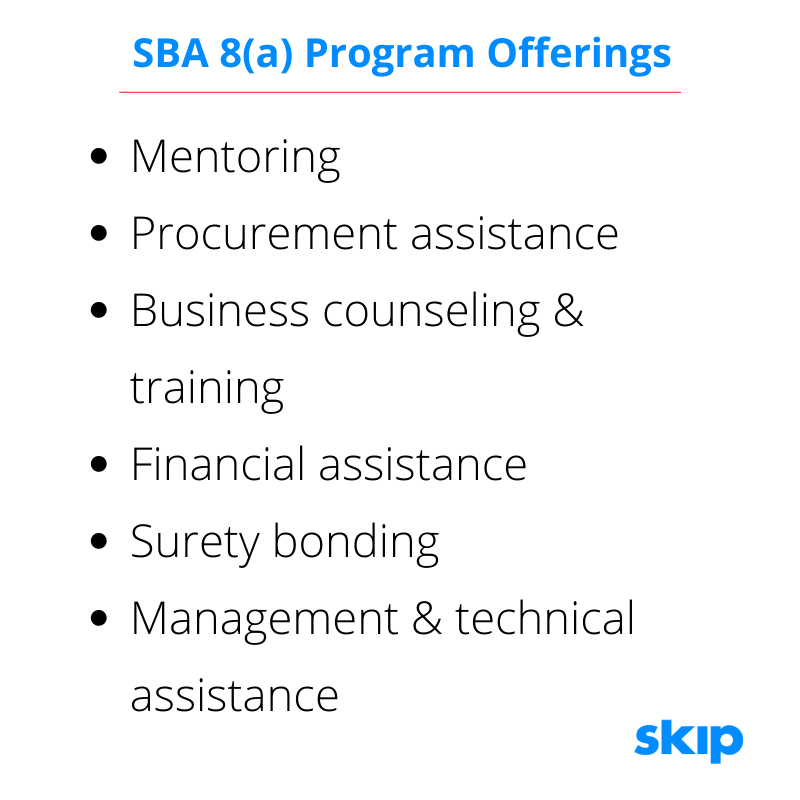The Ultimate Guide to the SBA 8(a) Program
If you’re a small business in search of funding, you’ve probably heard of the Small Business Administration’s (SBA) government-backed business loans.
However, you might not know about the SBA’s other assistance programs, like the SBA 8(a) program — designed specifically to help small businesses in underserved communities. In this article, we’ll introduce you to the SBA 8(a) program and discuss its benefits, who's eligible, and what you’ll need to apply.
SBA 8(a) Program Defined
The SBA 8(a) Program is not a loan. Simply put, it levels the playing field for underserved business communities when competing for government contracts during the competitive bidding process. 8(a) was designed specifically to assist economically and socially disadvantaged small businesses secure government contracts.
This nine-year program was designed to develop, train, and mentor businesses who want to bid on lucrative government contracts. Applying and competing for, government contracts is time-consuming, challenging, and intimidating at times — which is why the 8(a) program was designed.

SBA 8(a) Program Eligibility Requirements
Every year the U.S. Government sets aside 5% of its annual contracting budget for small businesses owned and operated by socially or economically disadvantaged business communities, defined by the SBA's Code of Federal Regulations (CFR). To be eligible for the 8(a) program, you must:
- Be a small business
- Have no previous participation in the 8(a) program
- Be at least 51% owned and controlled by socially and economically disadvantaged U.S. citizens (definitions below)
- Demonstrate good character
- Demonstrate success potential, e.g., be in business for two years
To be considered socially disadvantaged, you must have been subjected to ethnic prejudice or other cultural bias within American society. Additionally, the SBA classifies members of designated groups as socially disadvantaged, including:
- Black, Hispanic, and Native Americans
- Pacific-Islanders
- Native Hawaiian Organizations (NHO)
- Community Development Corporation (CDC)
- People with disabilities
- Members of the LGBTQ community, and others
The SBA defines economically disadvantaged as individuals with less access to capital than their non-economically disadvantaged business counterparts. To be considered eligible, an individual’s net worth must not exceed $250K.
The SBA also considers other income factors when determining program eligibility, however, once accepted into the 8(a) program, an individual’s net worth may not exceed $750K.
Requirements and Goals
The SBA's goal is to obtain an 8%+ graduation rate for its small business participants. Meaning, your small businesses grows into a competitive firm, successful in your market niche after completing the training.
Participants in the 8(a) program are required to:
- Maintain a balance between their commercial, and government contracts
- Limit the total value of sole-source contracts while participating in the 8(a) program ($100M, or five times the value of its government-assigned North American Industry Classification System (NAICS)
- Submit annual reviews, business planning documents, and undergo periodic and systematic evaluations to ensure 8(a) firms are on track to accomplish their business goals
SBA 8(a) Program Benefits
The 8(a) program is designed to help qualifying businesses compete for and attain coveted federal contracts. The numerous benefits of the program include:
- Enables businesses to compete for "set-aside" contracts and "sole-source" contracts.
- Assigns an Opportunity Specialist to business owners to assist with the application process and federal contracts as a whole.
- Provides business counseling, training, marketing assistance, executive development, business management, and technical training.
- Promotes business relationships through the SBA's Mentor-Protégé Program.
How to Get Certified and Apply for the SBA 8(a) Program
Prior to applying to an 8(a) program, businesses are encouraged to self-evaluate, and take an online training course covering all aspects of the program. Additionally, you'll also need to certify your business as economically, or socially-disadvantaged before participating in the 8(a) program. The process is fairly straightforward. Here are the steps:
- Create an account with Sam.gov
- Begin the certification process through the SBA's 8(a) certification website
- Review the Certify Knowledge Base for helpful information about the process
- Apply for SBA 8(a)
If approved, your business is entered into the Dynamic Small Business Search — the big database government agencies use when searching for certified and qualified contractors.
Your small business certification is valid for nine years – the first four years are considered “Development” and the final five years are "Transitional," meaning, after nine years, your business should be well established However, continuation in the program is dependent upon compliance with the program’s requirements.
For small businesses wishing to sell their products within the vast U.S. Government supply chain, the U.S. General Services Administration (GSA) is your number one resource for connecting with government and corporate enterprise buyers.
Subcontractors, look for subcontracting opportunities on Subnet, or find other businesses to partner with using the Dynamic Small Business Search tool.
Get Help for Your Business
Do you need help with you business budget or getting funding for your business? We can help you with SAM registration, SBA loans, grants, or other business financing options. Get ongoing personalized help from our team. Join Skip Premium today and get 1-1 support for your business.
How Else Can Skip Help? Whether you need assistance navigating funding for your small business — like SBA loans, grants, or other financing options, or guidance with government-related services — like TSA PreCheck or DMV appointments, we’re ready to help. Become a member and skip the red tape.